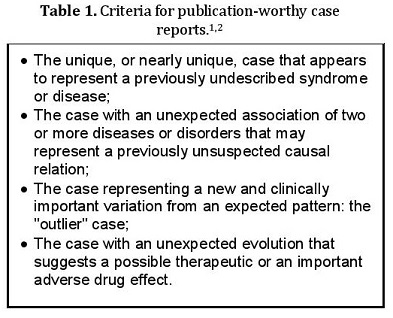The Case for Case Reports: Valuable Resource in ASEAN

Ours is an academic environment in which journal metrics has evolved into its own science. One cannot help but feel that published manuscripts to some people, are no more than figures that contribute to the computation of journal ranks, impact factors, or citation indices.
We wish to re-argue here, the case for case reports. We know that many reputable medical journals have reduced or even ceased publishing articles of this type. In the hierarchy of scientific publications, case reports rank lower than clinical trials. In the context of journal metrics, there is hesitation in publishing case reports as these are rarely cited, exerting a negative impact on the computation of a journal's impact factor.
The power of a good case report as an important learning resource for physicians and scientists, despite the above-cited odds, endures. Indeed, some of the most important discoveries, beneficial or otherwise, were first made public through case reports. Much of medicine's history was created with case reports as the sole source of scientific information. Examples abound of this type of manuscript as the first evidence for new surgical or medical treatments, as the first report of adverse effects of medications or modalities, and as the only way for describing rare diseases.
However, the responsibility lies with the editors to screen the good case reports from those of low quality and of limited value. This responsibility has never been more critical than in the present. In an environment of publish or perish and with the pervading perception of case reports as generally quicker and easier to write, the scientific community is subjected to a barrage of good and bad case reports. Edward J. Huth, renowned editor of Annals of Internal Medicine, laid down criteria that can guide editors in identifying publication-worthy case reports.

In the last four years, JAFES has received and rejected a good number of case reports. This is not intended to boost our journal's rejection rate; indeed, JAFES focuses more on its acceptance rate as a valid measure of the publication's quality control. What gets published eventually in each of our issues are the product of constructive inputs, recommendations, suggestions, and reviews, among the editors and peer reviewers of JAFES, including some case reports that were significantly reinforced by their authors during the peer review process.
Recognizing the value of these scientific anecdotes and experiences from our colleagues in Asia, we feature in this issue a collection of case reports, from rare diseases such as McCune-Albright Syndrome to rare presentations of endocrine tumors, from an experience with adverse drug effects to hormonal complications of disease. Some manuscripts have been submitted over two years ago, and we marvel at how the manuscripts evolved over time from their original raw submissions to their final forms, and these can only be possible through the patience of author, referee and editor. We believe that the lessons learned and the debates that arose from some of these case reports, are too valuable not to be shared with our readers. In fact, we included commentaries direct from our reviewers to add precious insights to the manuscript. We receive manuscripts also from outside the Southeast Asian region, and it is heartening to know that we are now expanding our reach.
With open arms, JAFES continues to welcome the interesting and the unique, the unexpected and the unfamiliar: the proverbial zebra with its horse-like hoofbeats. These are part and parcel of the large expanse of learning that, by design, cannot be supplanted by evidence-based medicine, known in parlance, as experience.
References:
1. Huth EJ. Writing and publishing in medicine. 3rd ed. Baltimore: Williams & Wilkins;199.p.103.
2. Albrecht J, Werth VP, Bigby M. The role of case reports in evidence-based practice, with suggestions for improving their reporting. J Am Acad Dermatol. 2009;60:412-8.
3. Patsopoulos NA, Analatos AA, Ionnidis JP. Relative citation impact of various study designs in the health sciences. JAMA. 2005;293(19):2362-6.
4. Bernhard JD. A case of too many case reports. J Am Acad Dermatol. 2001;45:773-4.
5. Albrecht J, Meves A, Bigby M. Case reports and case series from Lancet had significant impact on medical literature. J Clin Epidemiol. 2005;58:1227-32. [PubMed: 16291466]
6. Parente RCM, De Oliveira MA, Celeste RK. Case reports and case series in the era of evidence-based medicine. Bras. J. Video-Sur. 2010; 3(2):063-066.
7. Bavdekar SB, Save S. Writing case reports: Contributing to practice and research. Journal of the Association of Physicians of India. 2015; 63.